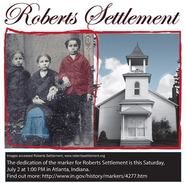Primary Source: Summer News from the Indiana Historical Bureau
State of Indiana sent this bulletin at 08/15/2016 03:21 PM EDT
Learn more about the Indiana State Flag! 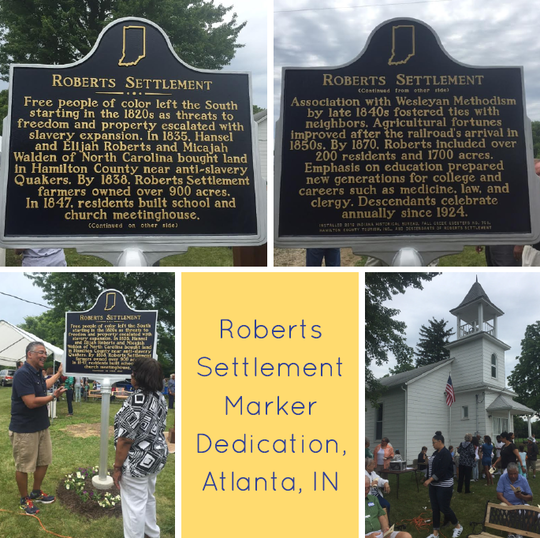 Roberts SettlementOn July 2, over 200 people gathered to celebrate the dedication of the historical marker for Roberts Settlement. Speakers included historians, politicians, and descendants of those original pioneers of Roberts Settlement. The event was covered by Indiana Public Media which posted a nice video summary of the event. The marker text reads:
Learn more about Roberts Settlement! 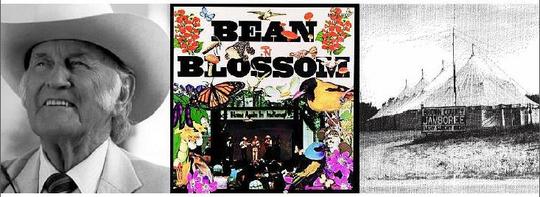 Brown County Bluegrass Music
|
 |
The Brown County Jamboree began informally in Bean Blossom as a free outdoor show featuring local musicians. Gradually commercialized and professionally promoted, the Jamboree drew large crowds by 1941, including attendees from other states. The rural country music park brought live country music to thousands of people and increased exposure for its musicians.Bill Monroe, award-winning musician and “Father of Bluegrass Music,” took charge of the music park by 1952 and continued the regular Jamboree shows. He hosted an annual festival starting in 1967. By 1971, it included international performers and by 1976 drew over 30,000 attendees. Monroe died in 1996, but the festival continues at the Bill Monroe Memorial Music Park. |
Learn more about Brown County Bluegrass Music! You can also learn about the roots of the Brown County Jamboree with Part One of our Bluegrass blog post and about Bill Monroe's time in Indiana in Part Two.

Upcoming Marker Dedication
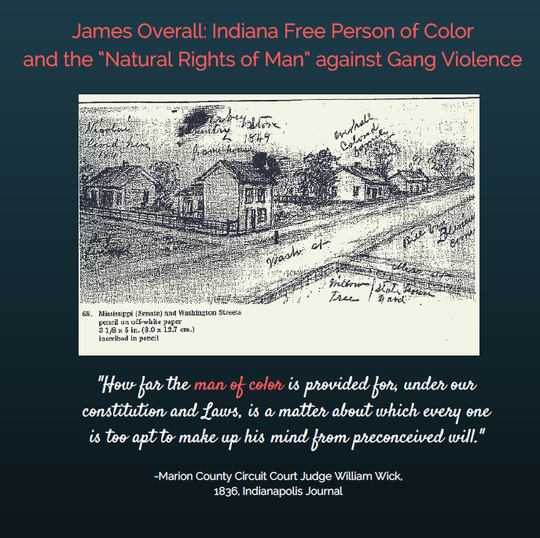
James Overall
The state historical marker honoring James Overall will be dedicated September 29 in Indianapolis. More details will be announced soon, but you can learn about Overall's battle for his rights from our blog post, "James Overall: Indiana Free Person of Color and 'The Natural Rights of Man.'"
James Overall's story illuminates race relations in the 1830s in the young city of Indianapolis. Overall was a free person of color, who owned land in Indianapolis and aided escaping slaves migrating from the south. On the night of March 18, 1836, white gang members attacked Overall's home. After shooting a gang member, Overall was aided by white residents like Calvin Fletcher, and appealed to Indiana's legal system to assert his rights.

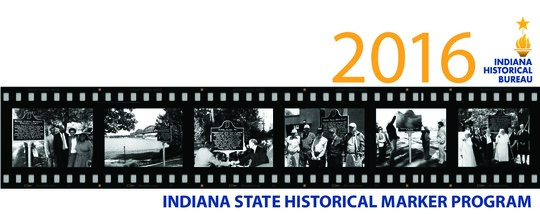
Don't Forget Your New Marker Application!
If IHB accepted your Intent to Apply form in the spring, your final Marker Application is due August 19. Find out more.

Julian to Pence: Hoosier VP Nominees
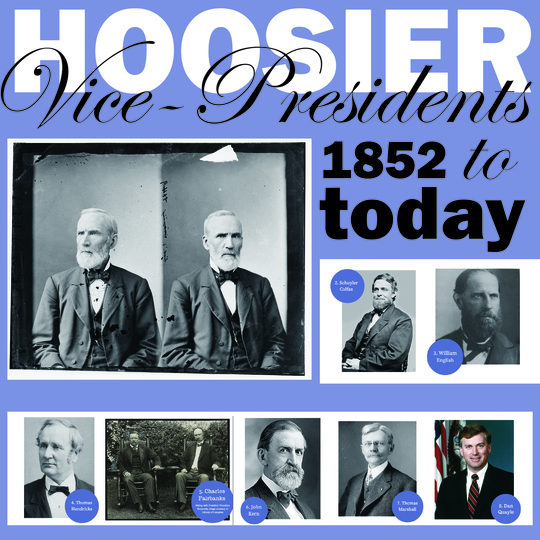
With the nomination of Indiana Governor Mike Pence for Vice-President, IHB took a look back at the other EIGHT Hoosier candidates who vied for the vice-presidency in the past.
We started with George Washington Julian’s 1852 nomination on the Free Soil
Party ticket. The Free Soil Party was a single-issue party dedicated to
opposing the extension of slavery. The party nominated Julian for vice
president alongside presidential nominee John P. Hale of New Hampshire.
Unfortunately for the Free Soilers and the
anti-slavery movement, people were more interested in maintaining unity for the
Union and were satisfied by a recent “compromise" on the issue. However,
Free Soil Party leaders, including Julian, went on to become essential in the
establishment of the new Republican Party a few years later.
Visit us on Facebook to learn about the other Hoosier vice-presidents.
Learn more about Indiana's first VP candidate through the post, "George Washington Julian: Radical Representative of Moral Conviction" on the IHB blog. The post explores his role as U.S. Congressman and active abolitionist and his changing party affiliation. His moral convictions are best represented in his strong speeches such as “The Slavery Question” (pictured below) which he delivered to the U.S. House of Representatives in 1850.
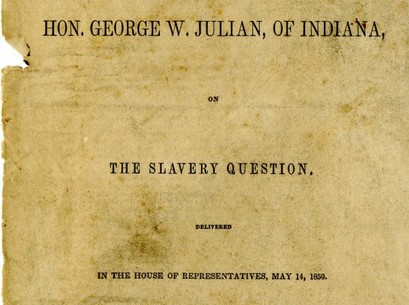

New IHB Collaboration
 |
IHB + INHistory
We’re excited to announce our collaboration with the Indiana Office of Technology. Check out the INHistory section of In.gov’s home page for our monthly compilation of notable Indiana history people and events. Visit the IHB Facebook page for daily doses of in-depth Hoosier history.
|

Popular Posts from the IHB Blog
Follow the Indiana Historical Bureau: Blogging Hoosier History for great posts on topics as diverse as Lew Wallace's conversation with "the Great Agnostic," Elvis's last concert, and the invention of the Drunkometer. One popular post was Lindsey Beckley's on Dr. Harvey "Old Borax" Wiley and His Poison Squad. From the post:
 |
When Dr. Wiley started his career in the mid- to late-9th century, the production of processed foods in the US was on the rise due to the increasing number of urban dwellers unable to produce their own fresh food. With little to no federal regulation in this manufacturing, food adulteration was rampant. Dr. Wiley made it his mission to prove the importance of food regulation. With the help of a group of men known as the Poison Squad, he did just that. Wiley was born on a small farmstead near Kent, Indiana on October 18, 1844. He went to Hanover College, served briefly in the Civil War, taught at Butler, earned a Ph. D. from Indiana Medical College, and then studied chemistry and grew interested in adulterated food at Purdue University. |
Wiley argued that mass-produced food, as opposed to food produced locally in small quantities, contained harmful additives and preservatives and misled consumers about what they were actually eating. In the coming decades, Wiley would prove that this theory was correct and serve as one of the public faces of the pure food movement.
In 1883, Wiley was appointed Chief Chemist of the Bureau of Chemistry, a division of the United States Department of Agriculture. While serving in this capacity, Wiley made the establishment of federal standards of food, beverages, and medication his priority. To this end, governmental testing of food, beverages, and ingredients began in 1902. The most famous of these tests were the “hygienic table trials,” better known by the name given to them by the media: “The Poison Squad" (pictured below).
Learn more about Dr. Harvey "Old Borax" Wiley and his Poison Squad.
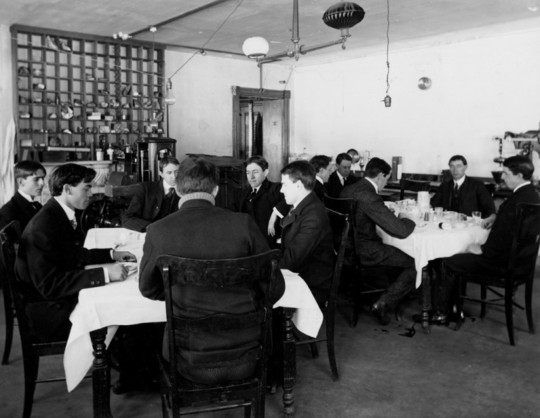

Want to Blog for IHB?We'd love to have you! Your post must be based upon original research or synthesis of well-researched secondary works and it should relate to Indiana history and describe the topic’s local, state, national and/or international significance. Learn More.
|
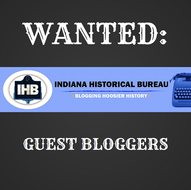 |

Hoosier Women at Work Conference
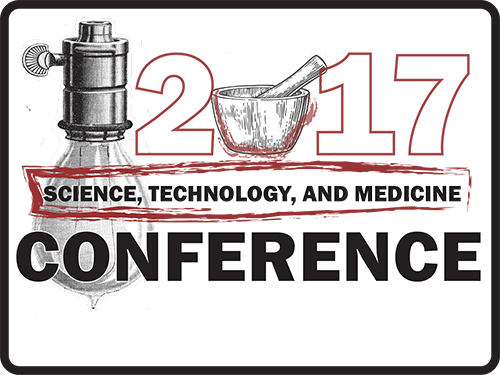
Building on the success of last year’s Hoosier Women at Work conference, the Indiana Historical Bureau and the Indiana State Library will host “Hoosier Woman at Work in Science, Technology, and Medicine,” a women’s history symposium, on April 1, 2017, at the Indiana State Library and Historical Building in downtown Indianapolis.
This one-day conference will explore and expand our knowledge of women’s contributions to Indiana’s science, technology, and medical fields via speakers, presentations, and panel discussions. Possible topics include: inventors/inventions; medical breakthroughs; agriculture and technology; public health; sanitation; exposure to hazardous materials in the work place; access to medical care; hospitals; women’s access to training and employment in any of these fields; and the impact of science, technology, and medicine on complicating or improving women’s lives.
View the Call for Papers for the 2017 Conference.
Why should we care about Indiana Women's History? Find out more about the need and demand for this conference: in.gov/history/hoosierwomenatwork

Help Care for Markers!
 |
Hunt for Hoosier History during Indiana’s Bicentennial
This year, during Indiana’s Bicentennial, IHB is working to complete a comprehensive survey of every state historical marker installed across Indiana since the mid-1940s – over 600! Thank you to everyone who has already submitted photos!
|
IHB is currently surveying the south and south central regions of the state and we need your help! If you live, work, or play by an Indiana state historical marker or come across any in your travels, please snap a few photos and send them to us at cpfeiffer@history.in.gov or tweet them to us @in_bureau. Feel free to make it a selfie! You may be surprised at the number of markers you pass each day.
Interested in learning about what markers are in your county? See our website for more information. Once there, you can also access additional information on the marker topic, including marker reviews, detailed annotations, and links to extra resources.
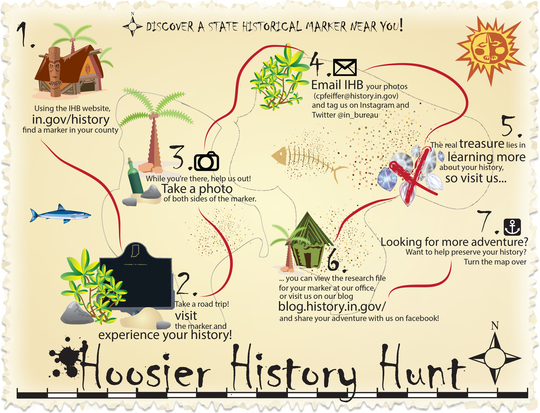
Get Involved!
Looking for a way to get involved during the Bicentennial? Consider repainting one of our state historical markers! IHB has seen a large increase in the number of groups and individuals interested in repainting markers this year. We want to extend a big thank you to everyone who has volunteered thus far and helped us preserve this history for future generations.
If you are interested in repainting a marker near you, please contact us at cpfeiffer@history.in.gov. This year’s volunteers have included county historians, local bicentennial coordinators, school groups, libraries, 4-H groups, and many individual citizens. Thanks to all!
Thanks!
Jim Dils, Wabash County Coordinator helped coordinate plans to repaint our First Electrically Lighted City marker on the southeast lawn of the Wabash County Courthouse in June. Many thanks to Jim for his work and to Dave Monroe, who donated his time to complete the repainting!


Amazing Centennial Video!
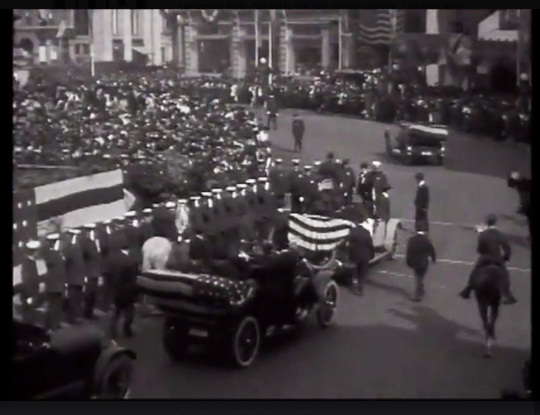
1916 Indiana Centennial
Indiana Historical Bureau staff located this 1916 Indiana Centennial film at the National Archives in College Park, MD. There are several other extant centennial films, but each one has unique content. The films were sponsored by the Indiana Historical Bureau's predecessor the Indiana Historical Commission. The films were probably originally part of a whole, but were subsequently edited and separated. The provenance of this particular film was that it came to the National Archives from the Ford Motor Company where it had been used to promote their Model Ts. You'll see a few of those vehicles in the film as well as James Whitcomb Riley, Meredith Nicholson, and Presidents Woodrow Wilson and William Howard Taft. If anyone can provide any info about any of the locations shown in the film, please let us know!
Watch the video on our Facebook page!

Ben-Hur: A Hoosier Masterpiece
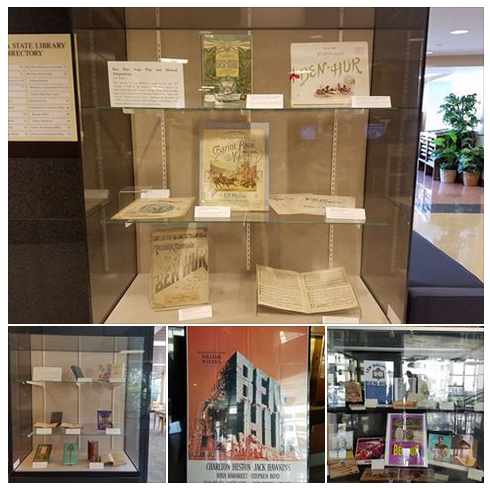
The Indiana State Library and Indiana Historical Bureau have new displays on Ben-Hur, written by Hoosier author Lew Wallace. These exhibits coincide with the new Ben-Hur adaptation opening in theaters August 19. Come visit us to learn more!
The Novel
Lew Wallace’s novel, published in 1880, became one of the best-selling American novels of all time. The fictional story revolves around Judah Ben-Hur, a Jewish prince enslaved by Romans when he’s falsely accused of a crime by his childhood friend. He becomes a soldier and charioteer ad seeks revenge for his enslavement and awful fates of his mother and sister. However, through his encounters with Jesus Christ and presence at the crucifixion, he changes his goal from revenge to redemption.
The Author
While Lew Wallace is best remembered as the celebrated Hoosier author of Ben-Hur, he was also a lawyer, a Civil War general, Governor of the New Mexico Territory, and an ambassador to the Ottoman Empire. He wrote most of Ben-Hur under a beech tree near his home in Crawfordsville. He later built a private study next to the “Ben-Hur Beech.” The novel established his fame as an author, placing him among other notable writers during the “Golden Age of Indiana Literature,” such as Hoosier poet James Whitcomb Riley.
Ben-Hur (The Stage Play)
The stage play of Ben-Hur opened on November 29, 1899 at the Broadway Theatre in New York City. Produced by Mark Klaw and Abraham Erlanger and adapted to the stage by William Young, the elaborate production required a treadmill and pulley system to stage the famous chariot scene with live horses. Over the 20-plus years of performances, it is estimated that over 20 million people saw the play and it grossed over $10 Million.
Ben-Hur (The 1925 Film)
In 1925,
Metro-Goldwyn-Mayer released their film adaptation of Wallace’s famous novel. Directed
by Fred Niblo, and with an estimated budget of $3,967,000, the film version was
shot on multiple locations, both domestically (Los Angeles, California) and
internationally (Rome, Italy). It also utilized a two-tone Technicolor
technique for specific sequences and the iconic chariot scene took nearly two
months to shoot. By 1932, the film had made an
estimated $10,738,000.
Ben-Hur (1959 Film Adaptation)
The 1959 adaptation of Ben-Hur was directed by William Wyler and starred Charlton Heston and Jack Hawkins. With the largest budget of any film up to that date, Ben-Hur became the highest grossing film of 1959. It would go on to win 11 academy awards, including Best Picture, Best Director, and Best Actor in a Leading Role.
2016 Ben-Hur Film Adaptation
With an expected release date of August 19, 2016, the newest adaptation of Ben-Hur is directed by Timur Bekmambetov and stars Jack Hutson, Nazanin Boniadi and Ayelet Zurer.

Back to School: Books for Kids
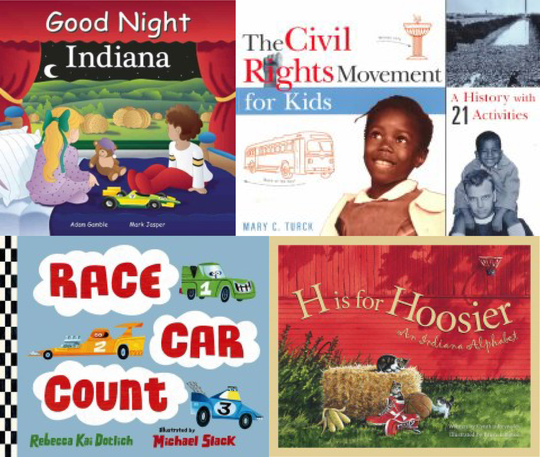
 |
25% Off Kids Book! Visit the Indiana Historical Bureau Book Shop either online or inside the Indiana State Library and Historical Building in downtown Indianapolis. During August and September all kids books are 25% off! We have activity books on the Civil War, the Wright Brothers, Latino history, Women's suffrage, and more. We also have biographies of prominent Hoosiers such as Abraham Lincoln and Gene Stratton-Porter at kids' reading levels. Check out the wide variety of kids' books! |
Shop the Bicentennial
Hoosier Pride
The IHB shop has everything you need to show your Indiana bicentennial pride! Check out our new stickers, replicas of the Soldiers' and Sailors' Monument, magnets, keychains, bicentennial medals and flags, locally made glass paperweights, and so much more! Visit us.
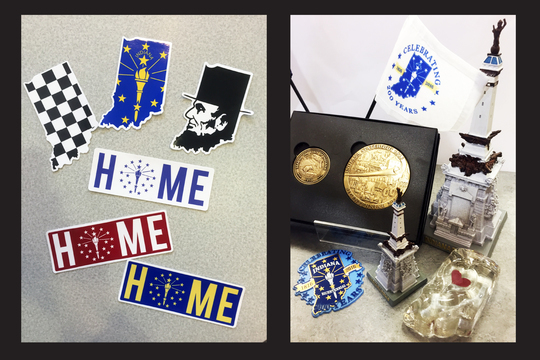

Stay Connected to History
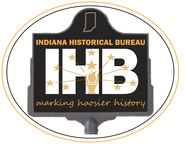 |
Join us on our blog for more in-depth Hoosier history. Follow us on Facebook, Instagram, and Twitter and you'll get Hoosier history facts, stories, and resources. Leave us comments too. We love hearing from you! Did you miss the spring issue? Read it here. |


IHB Summer 2016 Newsletter




